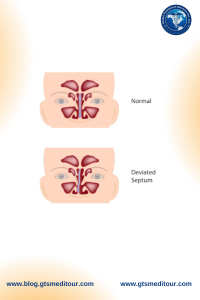Overview
Some people are born with a deviated septum, but it can also be caused by an injury to your nose. Most people with a deviated septum have one nasal passage that’s much smaller than the other. This can cause difficulty breathing. Other symptoms of a deviated septum may include frequent nosebleeds and facial pain. Surgery is the only way to fix a deviated septum(i.e, septoplasty)
Septoplasty is a minor, low-risk procedure inside your nose to straighten a deviated septum. It is generally performed to improve quality of life. Recovery usually takes a few days and requires an average of a week of downtime. But, as with any surgery, septoplasty carries some risks, including bleeding, infection and numbness.
Causes
The main reasons for this surgery are:
- To repair a crooked, bent, or deformed nasal septum that blocks the airway in the nose. People with this condition very often breathe through their mouth and may be more likely to get nasal or sinus infections.
- To treat nosebleeds that cannot be controlled.
- To help alleviate snoring resulting from a nasal blockage.
Potential risks of a septoplasty
- bleeding
- scarring
- perforation of your septum, which happens when a hole forms in your septum
- an altered nose shape
- a discoloration of your nose
- a decreased sense of smell
Excessive bleeding and infection are possible risks of any surgery. Keeping your nose clean and washing your hands frequently can reduce these risks.
Benefits
Septoplasty can improve airflow through your nasal passages. This can result in a number of benefits. For example, septoplasty:
- Treats breathing problems caused by a deviated septum, nasal polyps or other similar conditions.
- Can reduce or eliminate snoring, giving you a better night’s rest.
- Allows your sinuses to drain better, resulting in fewer sinus infections.
Conclusion
Septoplasty is a minor surgery that offers major benefits for many people. It can open your nasal passages and improve your breathing. The wound on your nose will heal fairly quickly, However, the overall healing process can be slow. Cartilage and other nasal tissues can take up to a year to fully settle into their new shape.Most people experience no ongoing symptoms after the surgery. In some cases, however, the cartilage and nasal tissues continue to shift over time and eventually block airflow through the nose again. This means that a second surgery will be needed to reshape the nose and septum further.
further if your loved ones or anybody in your family or friends circle suffering from deviation septum or breathing difficulty, you can email us your queries at query@gtsmeditour.com or WhatsApp us on +91 9880149003


Post a comment